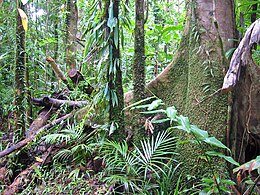| UNESCO World Heritage Site | |
|---|---|
 Forest near Daintree. Queensland | |
| Location | Queensland, Australia |
| Includes | components:
|
| Criteria | Natural: (vii), (viii), (ix), (x) |
| Reference | 486 |
| Inscription | 1988 (12th Session) |
| Area | 893,453 ha (3,449.64 sq mi) |
| Coordinates | 15°39′S 144°58′E / 15.650°S 144.967°E |
Components in Queensland | |
The Wet Tropics of Queensland World Heritage Site consists of approximately 8,940 km2 of Australian wet tropical forests growing along the north-east Queensland portion of the Great Dividing Range. The Wet Tropics of Queensland meets all four of the criteria for natural heritage for selection as a World Heritage Site.[1] World Heritage status was declared in 1988,[2] and on 21 May 2007 the Wet Tropics were added to the Australian National Heritage List.[3]
The tropical forests have the highest concentration of primitive flowering plant families in the world.[4] Only Madagascar and New Caledonia, due to their historical isolation, have humid, tropical regions with a comparable level of endemism.[2]
The Wet Tropics rainforests are recognised internationally for their ancient ancestry and many unique plants and animals. Many plant and animal species in the Wet Tropics are found nowhere else in the world. The Wet Tropics has the oldest continuously surviving tropical rainforests on earth.[5]
- ^ Cite error: The named reference
uwhcwhlwas invoked but never defined (see the help page). - ^ a b Steve Goosen & Nigel I. J. Tucker (1995). "Wet Tropics Overview" (PDF). Repairing the Rainforest: Theory and Practice of Rainforest Re-establishment in North Queensland's Wet Tropics. Wet Tropics Management Authority. Retrieved 21 March 2013.
- ^ "Wet Tropics of Queensland". Department of the Environment, Water, Heritage and the Arts. Retrieved 18 June 2010.
- ^ "Wet Tropics". Department of National Parks, Recreation, Sport and Racing. 14 May 2012. Retrieved 21 March 2013.
- ^ "World Heritage Values". Website Tropics Management Authority. Retrieved 25 May 2019.

